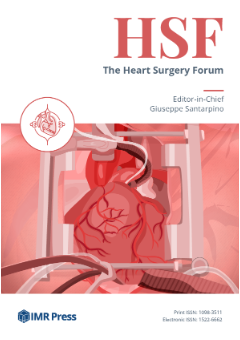Announcements
The Heart Surgery Forum (HSF) is published by IMR Press from Volume 28 Issue 9 (2025). Previous articles were published by another publisher under the CC-BY-NC licence, and they are hosted by IMR Press on imrpress.com as a courtesy and upon agreement.
Open Access
Article
Validation of Intracoronary Shunt Flow Measurements for Off-Pump Coronary Artery Bypass Operations
Heart Surg. Forum 2004, 7(1),
8–12;
https://doi.org/10.1532/hsf.1203
Published:
4 January 2005
Abstract
Introduction: Intracoronary shunting is a useful, easy and inexpensive technique to maintain blood flow during off-pump surgery to lessen myocardial ischemia. Intracoronary shunts should provide a minimal flow for adequate myocardial protection.Material and Methods: Two commercially available shunts were used to measure flow from a bulb-size diameter of 1.00 mm to 3.00 mm (n = 10) in an in vitro setup. Shunts were perfused with Glycerin 47% solution at 37 ° C. Inlet pressure was raised continuously from 0 to 160 mmHg in all intracoronary shunts.Results: In both groups (recipients of either type A shunt or type B shunt), mean pressure of 40 mmHg was necessary in shunts with diameter of 3.0 mm to provide a flow of approximately 50 mL/min. At mean pressure of 100 mmHg, a maximum flow of 126 mL/min was measured. Shunt B of 2.5-mm and 3.0-mm diameter showed similar flow patterns: 50 versus 52 mL/min at 40 mmHg and 98 versus 108 mL/min at 100 mmHg. Shunt A at 2.5-mm diameter showed 37 mL/min at 40 mmHg and 80 mL/min at 100 mmHg (P = .01). Shunt B at 1.5-mm diameter required 75 mmHg for approximately 40mL/min and showed maximum flow of 51 mL/min at 100 mmHg (P < .001). Only minimal flow was measured in 1.0-mm shunts of both groups.Conclusions: There is a clear pressure/flow correlation in 2.0-mm to 3.0-mm shunts with maximum flow of 126 mL/min. Type B shunt of 1.5-mm and 2.5-mm diameter showed significant better flow rates. The possible value of 1.0-mm shunts is only in stenting and facilitating anastomosis and to obtain better visibility during anastomosis.

